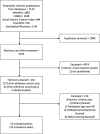Metasynthesis of Patient Attitudes Toward Bone Densitometry
- PMID: 30054881
- PMCID: PMC6153231
- DOI: 10.1007/s11606-018-4587-3
Metasynthesis of Patient Attitudes Toward Bone Densitometry
Abstract
Background: Bone densitometry (e.g., dual-energy X-ray absorptiometry or "DXA") is strongly associated with osteoporosis treatment; however, rates of DXA are low. While studies have demonstrated a continued need for primary care provider education on the role of DXA in preventive care, little is known about the role of patient attitudes toward DXA. This review's purpose is to synthesize the evidence about the effects of patient perceptions and experiences of DXA on osteoporosis prevention.
Methods: A metasynthesis was conducted of English language, peer-reviewed publications, searching relevant databases: MEDLINE, CINAHL, Web of Science Social Science Citation Index, PsycINFO, and Sociological Abstracts. Identified articles' quality was appraised using the Critical Appraisal Skills Programme (CASP) Qualitative Checklist, and an iterative process of data evaluation, integration, and synthesis was used to develop the findings.
Results: Thirteen articles from ten studies were identified, composing an aggregated sample of 265 people (231 women). Participant attitudes toward screening ranged from receptive to ambivalent to concerned about results. Participants' understandings of DXA and its role in clinical care were limited. Knowledge of osteoporosis was also partial and influenced by lay sources, the media, and health care providers. Primary care providers strongly influenced participant behavior, especially if participants had a more passive approach to health care. Participants reported less concern about expected barriers of health care access and cost.
Conclusion: Minimal knowledge exists of patient perceptions and experiences of DXA among those who are fracture naïve: Prior research has focused primarily on secondary fracture prevention contexts. Our metasynthesis reveals patients' significant reliance, given their limited risk appraisal and knowledge, upon primary care providers in decision-making. We urge colleagues to conduct qualitative research on DXA barriers among general primary care population in order to facilitate health care delivery systems better equipped to diagnose and treat patients before their first fracture.
Keywords: Osteoporosis; Preventive care; Qualitative research; Systematic reviews.
Conflict of interest statement
The authors declare that they do not have a conflict of interest.
Figures
References
-
- Becker D. J., Yun H., Kilgore M. L., Curtis J. R., Delzell E., Gary L. C., Saag K. G., Morrisey M. A. Health Services Utilization After Fractures: Evidence From Medicare. The Journals of Gerontology Series A: Biological Sciences and Medical Sciences. 2010;65A(9):1012–1020. doi: 10.1093/gerona/glq093. - DOI - PubMed
Publication types
MeSH terms
Grants and funding
LinkOut - more resources
Full Text Sources
Other Literature Sources
Medical


